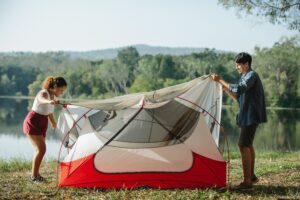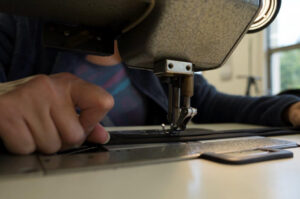How to choose tents
How to choose tents
The first and very important is the water resistance of the tent and this is a crucial aspect. Every honest manufacturer produces suitable tents for specific and intended purposes.
The water resistance of the tent is indicated by the water column, but it is not the same for all manufacturers. So let’s watch the water permeability of the water column at the floor of such a tent – quality tents tend to be between 5,000 and 10,000 mm. Additional water resistance can be provided by a polyurethane (PU) coating, single- or double-sided siliconization or DWR (water-repellent) treatment. Some materials with PU coating due to exposure to solar UV radiation lose their properties over time, so the best is silicone, which is a durable and reliable protection against water.
However, both technologies mean that the tent will not be suitably breathable. Another issue is that the seams of the tent where the stitches of the ball is connected are glued, welded or coated. But in the past, such things have not been much addressed.
Let’s remember the old military tents or tarps from which a military tent could be built. It was important for such a shelter to last and provide shelter for the person in bad weather. If it was flowing into the tent, it was always easy to help one impregnate the tent at home against water penetration.
Types of tents according to purpose
Tourist tents
A tourist tent is the most commonly used type of tent. It is relatively comfortable and offers good dimensions and acceptable weight (approx. 2.5 – 5 kg).
These tents are a choice for use both in the camp, on the water and on undemanding frictions. They are usually chosen according to the number of people – two-, three- or four-digit (and different variants as for 2.5 people, etc.).
The offer of tourist tents is very extensive, from cheap tents for a few dollars that flow during the first storm, have weak stitching and anchoring is for children and in the first wind the tent flies away or is damaged under a fallen small branch to tents designed for worse and harsh climatic conditions.
Family tents
These are tents designed for camping for long-term stays. Such a tent must offer above all for comfort and endurance.
It should be more spacious, because in bad weather the whole family will be with children and they will play games and it has to be thrown in comfortably and going out.
Some walls are high for a standing person and the advantage of such a tent is a spacious hall for storing things.
Since the stand will be exposed to weather conditions (sun, rain) in one place for many days, we are concerned with the quality of materials that otherwise wear out quickly.
The values of the water column and the materials used are therefore important. Such a tent has a greater weight, but we do not mind because we transport it to the place by car. But even here it is true that the solid construction is the basis for a quality tent.
Expedition tents
These tents are designed for alpine tourism, deep forests where the climatic conditions are very demanding.
Their use is on expeditions (as the name suggests), or for a longer stay in nature, for example (long trek, etc.).
Expedition tents often weigh more around (from 1 kg per person). These are tents or shelters that are very resistant to strong winds and rain. They have firm eyes for anchoring and a firm connection in the seams.
Their advantage is therefore high quality and durability and great security in their use in harsh conditions.
Ultralight tents
Ultralight equipment has been popular recently. If you actually carry your entire „house“ on your back for days, you know every gram.
Manufacturers usually indicate ultralight tents that weigh up to 2.5 kg for 2 persons and max up to 2 kg for 1 person.
Some tents weigh less than 1.5 kilos for 1 person and that’s really very little. Such an ultralight tent is good, but don’t expect much stamina from it again. The problem is again that some manufacturers offer bad workmanship for these tents and that is bad.
You pay unnecessarily many dollars for a poor quality product.




